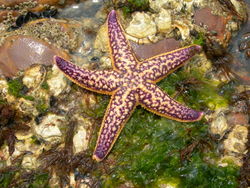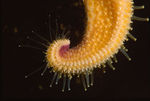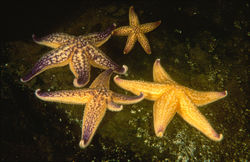| Northern pacific seastar |
 |
| Scientific Classification |
|
|
| Scientific Name |
Asterias amurensis |
|
|
| Several Northern pacific seastars |
The Northern pacific seastar is a species of starfish known by the scientific name Asterias amurensis. It is native to Japan, Russia, North Korea, and China. The average life span of this particular sea star is 10 years, but one could live for up to 50 years[2]. They were invasively introduced to Australia and New Zealand by fish trade and were transmitted through ship ballast water and through water currents.[3]
They can grow up to 50 cm in diameter. These sea stars are usually orange or purple in color, and have 5 arms. They are natively found in waters of 7-10°C, but have adapted to slightly warmer and colder water. They can be seen in estuarine, and marine habitats. The Northern Pacific Sea star's diet consists of mollusks, barnacles, crabs, crustaceans, and worms.[4] Some methods being used to control this invasive species involve biological use, collecting, trapping, and the use of chemicals.[5]
Body Design

These are the irregularly arranged spines that move food along to the mouth
The body color of this seastar usually ranges from orange to purple. It is sometimes confused with Australia's native five armed seastar which is also orange in color, but it has rounded tips that are not curled. This seastar has five arms. Their arms are usually pointed at the end and the tips are often curled upwards.[6]
Their body can reach forty to fifty centimeters in diameter. [7] Irregularly arranged spines on each arm come together near the mouth area to form a fan like appearance. There is no difference in body design, other than the testes and ovaries, for different sexes.[8] They can regrow body p[arts and have a complex central nervous system, but not a real brain. Their life is just finding food and avoiding predators. They feed on mostly mussels, clams, and oysters. Some have the unique ability to digest food outside the body.[9]
Life Cycle
The Northern Pacific Seastar develops through metamorphosis.This means that once the egg is fertilized, it starts larval development. Once the gastrovascular canals, which is the primary organ for digestion, appear and the larva starts to feed, it is called a bipinnaria. Later, this stage forms brachiolar arms and the brachiolar complex. This is when the larval stage transitions to the brachiolaria state. After this, it will metamorphosize into an adult sea star. The process of metamorphosis, from the moment of fertilization, to becoming an adult sea star, takes as little as 41 days to as much as 120 days. The warmer the temperature of the water that the sea star is in, the quicker the process of metamorphosis will occur. They reproduce both sexually and asexually[10]. In sexual reproduction, once the females release their eggs into the environment surrounding them, the male sea stars release their sperm (the mature male sex cell that fertilizes the egg) [11], externally fertilizing the eggs. In Japan, the Northern Pacific Seastars spawn between January and April. However, in Russia and Australia they reproduce from June to October. During the annual breeding season, which normally occurs in either late winter or early spring, individual sea stars can procreate multiple times [12]. Typically, a sea star has a life expectancy of around 10 years, though they are capable of living to be around 50 years old.
When both male and female sea stars are 3.6 to 5.5 centimeters in length, they have reached sexual maturity. Females can be differentiated from males for 5-6 months in the year by the appearance of their maturing ovaries (a female reproductive part where the eggs are produced) [13]. Mature ovaries are orange in color and are constantly releasing eggs (which contain the developing embryo) [14]. Female sea stars can hold anywhere from about 10-25 million eggs. For about 6 months of the year, male Northern Pacific Seastars can be identified reproductively by the brownish-yellow color of the testes (the male reproductive organ that produces sperm) [15]. The pores which are used in gamete (reproductive cell)[16] expulsion have direct contact with the marine environment, giving these sea stars what are called ectosomatic organs.
Ecology

asterias amurensis (northern pacific seastar)eating a clam using its arms to cover and open it up and evert its stomach to digest the clam
Northern Pacific Sea Star mainly lives in estuarine and marine habitats. Its water temperature can tolerate other temperatures with a maximum of 25°C and minimum of 0°C. Such as in Australia it has proven to adapt to a temperature of 22°C. Its salinity range varies from 18.7 and 41ppt, it can also tolerate a wide range of salinity. Commonly found in shallow waters off of coasts and on muddy, sandy, or rocky sheltered areas. [17] It is found throughout parts of the Pacific Ocean, native to Japan, Russia, Northern China, and Korea.
The northern pacific sea star has a wide variety diet, will generally eat any sea creature they encounter. Common ones are mussels, scallops and clams. If food source is low they will exhibit cannibalistic behavior. They eat food by using their arms to pull apart the shell (if the organism has one) and evert their stomachs into the shell cavity. They also may eat gastropods, crabs, barnacles, and algae. They may be seen digging in the ground looking for prey. In certain ecosystems, its main role is an invasive species. Can also be an obligated predator, which has a huge affect on benthic infauna.
This species is commonly known to host the bacterium Colwellia asteriadis. In general the sea star doesn't have that many predators ,but it is eaten by the Alaskan king crab and Japanese sun star.[18]Uniophora granifera (rough seastar), Coscinasterias muricata (11 armed seastar) and Odobenus rosmarus divergens (pacific walrus) all compete for food with the northern pacific seastar.[19]
Invasive Species
Location and Method of Introduction
Northern Pacific Seastars, native to Japan, Russia, Northern China, and Korea, were introduced into parts of the Southern Australian coast (specifically Tasmania), Alaska and the Aleutian Islands, and Europe, as well as the state of Maine [12]. They were accidentally transported from places they were native to, such as Japan, in the ballast water (water held in tanks and cargo holds of ships to increase stability and maneuverability) of the boats going to and from places where this sea star is native to and other places which are harmed by the presence of the Northern Pacific Seastars, which is what makes it an invasive species. [10]. In a matter of two years, the population reached 12 million in Port Phillip Bay (located in Victoria, Australia) [10]. This invasive species, though natively lives in water of about 7-10 degrees Celsius, has now adapted to survive in the warmer waters of Australia (about 22 degrees Celsius), and can tolerate as high as 25 degrees Celsius and as low as 0 degrees Celsius. [10]
Environmental Impact
These animals are known to have a great impact on their new environment. They are also an unnatural predator of many native animals. The northern pacific seastar is responsible for endangering many animals such as the native shellfish and the spotted handfish. It also impacts shellfish farming and has cost the shellfish farming industry millions of dollars. This seastar is reported to have a great impact on oyster production. It has potential to reproduce rapidly and cover large areas. Recent estimates show that there are over twelve million in two years IN Australia. [20]
Control Methods
The asterias amurensis (Northern Pacific Seastar) is ranked as the most potentially damaging invasive species in Australia. They have been damaging the shellfish and negatively impacting the fishing industries, causing a one billion dollar loss in the industry. Ways people have done to control this matter is by allowing a "sea star hunting day." This enables people to go out and hunt the sea star, several thousand sea stars have been removed this way.[21]. Scientists have tried genetic manipulation. They insert or change certain genes which will castrate the sea star and make it kill its own young. Changes in salinity were proven successful in a series of experiments. [22].
Fresh water is very dangerous to the Asterias larvae, they can not survive in the fresh water when they are young and they don't have as wide rage of salinity compared to the adult sea star. People have tried manually removing the sea stars through diving, collecting, trapping, netting, and commercial harvesting for fertilizer. Trapping and netting has been proven to have limited success while diving and collecting are completely unsuccessful. Commercial harvesting is also limited successful. In mid-1993, the sea star was made into fertilizer suitable for soil. People didn't show much interest in this way of control method [23]. Another way of controlling the sea star is by biological control. The orchitophyra stellarum (parasitic single-celled organism) has been used as a biological control method of the sea star. These parasites infest the gonads of the starfish preventing reproduction and population growth. This has been proven to be semi-successful.[24].
Video
Annual invasion of the Northern Pacific Seastar at Mornington Pier in Melbourne Australia.
References
- ↑ Asterias amurensis Wikispecies. Web. last edited December 4, 2016. Author Unknown.
- ↑ Foram Shah and Shikha Surati. asterias amurensis Animal Diversity Web. Web. Accessed November 13th, 2017
- ↑ Asterias amurensis JMTD. Web. Accessed November 13, 2017.
- ↑ Chantal Stevens, Deborah Rudnick. Asterias amurensis (sea star) Global Invasive Species Database. Web. March 10th, 2010
- ↑ Chantal Stevens, Deborah Rudnick. Asterias amurensis (northern Pacific seastar) cabi. Web. October 11th, 2017
- ↑ Northern Pacific Seastar Boating Industry Association of Australia. Web. Published April 10, 2014. Unknown Author.
- ↑ Northern Pacific seastar in Australia revolvy.Web. Received Information July 16, 2010. Author unknown.
- ↑ Asterias amurensis Animal Diversity Web. Web. accessed November 5, 2017. Author Unknown.
- ↑ starfish BioExpedition.Web. accesed nov 13, 2017. Author unknown.
- ↑ 10.0 10.1 10.2 10.3 Asterias amurensis Japanese Tsuanmi Marine Debris database. Web. Accessed November 13, 2017. Author unknown.
- ↑ Sperm Dictionary. Web. Accessed November 13, 2017.
- ↑ 12.0 12.1 Shah, Foram/ Surati, Shikha. Asterias amurensis Animal diversity Web. Web. Accessed November 13, 2017. Author unknown.
- ↑ Ovary Google. Web. Accessed November 13, 2017.
- ↑ Egg Google. Web. Accessed November 13, 2017.
- ↑ [1] Testes Google. Web. Accessed November 13, 2017. Author Unknown
- ↑ Gametes Dictionary. Web. Accessed November 13, 2017.
- ↑ Stevens, Chantal, Dr. Rudnick, Deborah. Asterias amurensis (sea star)"Global Invasive Species Database".Web. March 10th 2010.
- ↑ Shah, Foram and Surati, Shikha.Asterias amurensis Animal Diversity Web. Web. Accessed November 5th, 2017.
- ↑ Asterias amurensis"CABI".Web. Modified march 10th, 2010.
- ↑ Environmental Issues weebly. Web. accessed November 12, 2017. author unknown
- ↑ Shah, Foram Shah and Surati, Shikha .Asterias amurensis Animal Diversity Web. Web. Accessed November 11th, 2017.
- ↑ Stevens, Chantal and Dr. Deborah Rudnick .Asterias amurensis (northern Pacific sea star) CABI. Web. last modified October 11th, 2017.
- ↑ Stevens, Chantal and Dr. Deborah Rudnick .Asterias amurensis (northern Pacific sea star) CABI. Web. last modified October 11th, 2017.
- ↑ Asterias amurensis by the ciliate Diseases of Aquatic Organisms. Web. published March 27th, author unknown.




